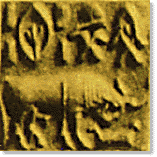
14. An Indus Seal from Mohenjo-daro
Another diacritic sign is drawn either directly or obliquely across the body of the 'fish' pictogram (Fig. 14, 13c). It could denote 'halving' or 'dividing into two parts': the corresponding Proto-Dravidian root, *pacu , is homophonous with Proto-Dravidian *pacu 'green'. The resulting compound, * pacu-meen 'halved fish' & 'green star', is not known as such from Dravidian languages, but in Old Tamil the word paccai literally meaning 'greenness' is attested as the name of the planet Mercury, and simultaneously as the name of the green-hued pastoral god Krsna.
The Indus script is normally to be read from right to left. (This is usually the direction of writing in the seal impressions, while in the original seals - such as those illustrated in Fig. 14 - the direction of writing is reversed.) The sign of 'two long vertical strokes' (on the right) followed (on the left) by the plain 'fish' pictogram can be shown to form one syntactic unit by means of a structural analysis of the Indus inscriptions. They are likely to have formed a compound (Fig. 13 d). But how to read the pictogram consisting of 'two long vertical strokes'? Such a simplified symbol can be pictorially interpreted in many different ways. For example, it could be assumed to denote 'two', or 'pair', or 'path', or 'parallel'. In the absence of any idea about the intended meaning of the 'fish' pictogram, it would be difficult to decide which, if any, of these possible interpretations is correct. The above suggested ways of reading the 'fish' pictogram and its attributes, however, make it possible to approach the present case from a different angle, and to use it as a test. Supposing that we are right in assuming that many of the stable combinations of Indus pictograms ending in the 'fish' sign denote Dravidian planetary names of the type 'COLOUR' + ('fish' =) 'star', do any of the actually attested Dravidian compounds of this type provide a colour term having a homonym that would adequately fit the pictorial form of the sign 'two long vertical strokes'?
The word for 'white' that has the widest distribution among in the Dravidian languages is vel. The compound vel + meen (assimilated into vel-meen ) 'white (or bright) star' is known from Old Tamil as the name of the planet Venus, that brightest star of the morning and evening sky; and the noun vell-i , derived from the root vel , denotes 'planet Venus' in a number of Dravidian languages. The meaning of its homophone veli 'enclosed or intervening space, open space' could hardly be expressed better pictorially by any other symbol than 'two long vertical strokes'.
In Tamil, at least, the word velli is used not only in the meaning of 'planet Venus' but in the general meaning of 'star' as well.
 15. An Indus Seal from Harappa.
15. An Indus Seal from Harappa.
It is highly significant to observe that in the Indus script, the pictogram of 'two long vertical strokes' is used not only as an attribute of the 'fish' pictogram (in the above discussed compound read as vel + meen 'white star = Venus') but also as its synonym: both pictograms, the plain 'fish' as well as the 'two long vertical strokes', occur as if they were the latter member of a compound in the Indus texts in identical contexts, namely, immediately after a 'fig tree' pictogram (Fig. 13e, 15). We shall now consider the significance of this first member and of the resulting compound.
[Originally published as Parpola, Asko (1988) Religion reflected in the iconic signs of the Indus script: penetrating into long-forgotten picto+graphic messages. Visible Religion 6: pp. 114-135.]
